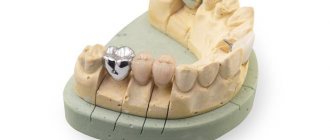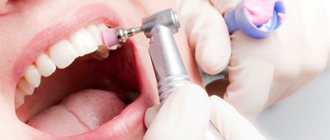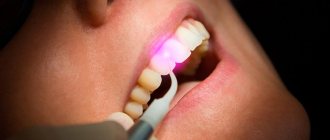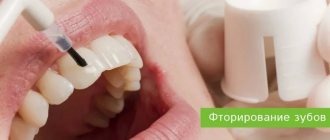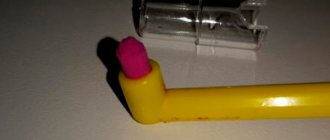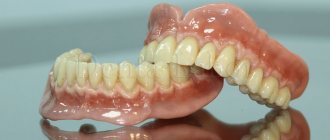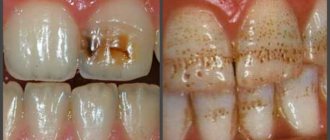- Veneers and facial proportions
- Articulator, occluder and facebow
- Veneer for one tooth
- Live or dead tooth - veneer or crown
- Zirconium veneers
- Veneers for crooked teeth
- Lumineers
- Veneering
- Dietary restrictions with veneers
- How to care for veneers
- Whitening before installing veneers
- Change (replace) veneers
We have already talked about the differences between composite and ceramic veneers, indications and contraindications for the installation of veneers, today we will continue the topic of artificial onlays on teeth and look at such concepts as “lumineers”, “veneering” and touch on other important points. Our interlocutor is Tamara Kazbekovna Alakaeva, maxillofacial surgeon, orthopedic dentist .
— Tamara Kazbekovna, they say that installing veneers helps solve problems not only with a smile, but also with age-related changes on the face. This is true?
Partly. Let me give you an example. We recently had a patient whose teeth were fine except for minor problems that could be corrected. But with age, the teeth on the lower jaw were worn away. Because of this, the load on the temporomandibular joint began to be distributed incorrectly. The lower third of the patient's face was low, the nasolabial folds were strongly pronounced, and the corners of the mouth were drooping. The face acquired an “senile” appearance. Some will say that you can consult a cosmetologist and solve age-related problems by introducing fillers, but one of the reasons for the formation of these age-related changes is an incorrect bite. We also found out from the patient’s medical history that he had severe tooth wear due to bruxism. That is, in this case, the patient’s teeth need to be restored to normal height.
In such cases, at the initial stage we use a facial bow apparatus, with its help we take an impression and install plaster models in the articulator apparatus.
— Tell us more about the articulator.
Using an articulator, we determine the position of the upper and lower jaws and the trajectory of movement of the lower jaw. As you know, our lower jaw moves, while the upper jaw always remains motionless. It is visually difficult to determine the features of the patient’s dental system. In such cases, the articulator helps.
For example, to determine the position of the upper jaw in relation to the skull, an impression of silicone material is taken and a face bow is installed. The facial arch runs along the pupillary line, the tragus of the ear and nose and on the teeth of the upper jaw. This way we can determine the position of the upper jaw in relation to the bones of the skull. The model is cast from plaster and installed in the articulator.
To determine the height of the lower jaw, we ask the patient to close the jaw and look at its position. Then we ask you to close your jaw so that only your lips touch each other, and your teeth do not close together. Determining the height.
Next, we determine the height of the facial part from the hair growth to the eyebrow border. Then from the eyebrow border to the columella of the nose and to the chin. The size must match. The height of a person’s forehead can change; for example, in men, a receding hairline may appear with age.
After the preparatory work has been done, we proceed to the jaw. It is necessary to raise the height of the lower jaw teeth gradually to avoid a large load on the temporomandibular joint. For two months, the patient walks with temporary veneers and temporary onlays on the chewing teeth. If he is comfortable and does not feel pain, then the temporary structures are replaced with permanent ones. This is a very large and lengthy job: we grind the teeth, do wax modeling, try on veneers, and correct the work.
- What if it’s just the opposite case? The patient is doing well, but he doesn’t like literally 1-2 teeth in the smile area. Is it possible to place only one or two veneers?
Such cases occur, for example, when a person may lose part of a tooth (severe chipping). Of course, we will do one or two veneers. But you need to understand that the fewer veneers we make, the more difficult it is for the dental technician to get the color right. That is, over time, it is possible that adjacent teeth will begin to differ.
— That is, one veneer in the smile area will be noticeable?
It all depends on the skill of the dental laboratory. We photograph the patient, and the dental technician necessarily conducts an examination in daylight and artificial light. In our practice, there was a case when a piece of the crown that was installed on the front tooth broke off. The difficulty was that the adjacent teeth were also artificial, and we did not know what material the adjacent crowns were made of. Technicians work with different masses and colors, each has their own approach and view, so, of course, it is very difficult to get the color of artificial teeth.
— It turns out that in such cases it is better to put veneers on all central teeth?
If a piece breaks off on one tooth, and the tooth next to it also doesn’t look aesthetically pleasing, then it makes sense to put veneers on both teeth.
— You said that veneers should be placed only on “living” teeth.
Yes, crowns should be placed on dead teeth. Depulped teeth become fragile, most often they are already destroyed, so the veneer here will not hold securely and provide functionality.
— How to treat teeth in case of caries if there are veneers on the teeth?
When installing a veneer, the back of the tooth is not affected. If the patient has any problems with this tooth, they can be easily solved since it is accessible.
What you can and cannot eat after installation of veneers and lumineers
If you have veneers and lumineers, the most important thing is to limit the load on the front teeth. That is, give up anything solid—excessive pressure can cause the plates to crack or peel off.
- do not bite off any food, even the softest. You need to get used to cutting or separating foods into small pieces - this applies to vegetables, fruits, meat, crackers and even cookies. Chew only with lateral teeth without overlays,
- give up the seeds - at least peel them by hand and chew them with your side teeth,
- use fibrous foods with caution - they can get stuck in the interdental spaces - it will be quite difficult to remove them with dental floss,
- it is necessary to abandon “coloring” foods (beets, red wine, black tea, coffee) or minimize their consumption, since the risk of changing the shade of dentures, especially composite and ceramic ones, significantly increases,
- Sudden changes in temperature (first eating hot meat, then drinking it with cold milk) are prohibited, as are too hot or cold foods and drinks - this can lead to cracks in the material and resorption of the composite glue. Ultimately, the overlay will simply come off.
There is absolutely no difference between veneers and lumineers in terms of care. They are fixed equally well, but veneers may fit the gum a little less tightly - the thicker the plate, the more “step” remains between the veneer and the mucous membrane. It can chafe and cause inflammation. Therefore, it is the gums that need to be given the most attention after restoration.
Sign up for veneering with a discount:
— It turns out that such designs do not differ in quality?
We have repeatedly had patients who installed such structures about a year and a half ago. They all complain about chips and that their teeth have begun to crumble. Of course, at the installation stage, the doctor warns about the risks, because the structure is fragile and unreliable. In addition, there is also a list of dietary restrictions. Despite this, patients agree to such designs, and then come to us to correct the situation.
— What are the dietary restrictions if good ceramic veneers are installed?
Not worth it
gnawing hard food such as nuts, apples, carrots... After all, a person bites just with the front teeth on which veneers are installed. Although, today dentists give such recommendations not only for artificial teeth, but also for their own. Biting off hard objects also harms your teeth, without aesthetic pads. You should eat according to the rules of etiquette).
— How to care for veneers?
Maintain oral hygiene: use good toothpastes, brushes, and, of course, dental floss; ideally, supplement your care with an irrigator. You should visit your doctor every six months for a check-up. You should not neglect professional teeth cleaning once every six months.
If you follow all of the above, you will be able to avoid many dental problems and the veneers will last for many years.
— Do veneers shrink like crowns?
If we talk about ceramic veneers, then no. Veneers made from cheaper materials shrink like fillings.
Another important point is to cover the contact areas of the teeth when installing veneers. If the veneer does not extend beyond the contact part of the tooth and remains only on the front surface, then the contact of the tooth tissues with food remains, and caries may occur. This happens because food gets stuck between the veneer and the tooth.
Many patients are afraid that their teeth will be ground down more than necessary. But we explain that this is insurance against the occurrence of caries in the future. Also, with this installation of veneers, if you look at the tooth from the side, you will not be able to see the junction between the veneer and your tooth. Over time, even whitened teeth change color, whereas this does not happen with veneers. If you do not “capture” the contact, the difference in color will be noticeable.
The photo shows ceramic veneers . The work of Dr. Tamara Alakaeva.
— Let's talk about whitening before installing veneers
Dentists have such a thing as a “smile line.” This line runs from the fifth to the fifth tooth, that is, ten teeth at the top and ten teeth at the bottom. If a patient wants a “Hollywood smile” with veneers, then we can achieve this effect by installing veneers.
Most often the upper teeth are visible. The lower teeth are only visible when a person is talking. If the structure of the lower row of teeth suits us, or the patient wants to save money on installing veneers, then in this case we whiten both jaws. Most often we use Zoom 4 teeth whitening on both jaws. At the same appointment, the doctor takes an impression for wax modeling.
The next appointment is scheduled in a week - that’s how long it takes to match the color. All this time, the patient adheres to a special diet so as not to spoil the color of the whitened teeth.
At the next visit, if the patient is satisfied with the result of whitening, we leave the color; if not, we make individual trays, and over the next week the patient independently maintains night whitening. At the same time, the process of making a wax model for veneers is completed. The shape, color and structure of the veneers are also discussed with the patient. In some cases, we model the future smile (teeth) on a computer using special programs. If the patient is satisfied with the design, we make artificial mouth guards. We discuss how much it is necessary to grind the teeth in order to get the ideal sized veneer. We discuss its color and shape. Naturally, all materials are agreed upon with the patient at each stage.
In general, the procedure for installing veneers is not painful. The exception is when it is necessary to perform gum retraction. We do this under local anesthesia.
On average, the procedure for installing one veneer takes about forty minutes, and this also includes time for impressions. The duration of the entire procedure for installing veneers depends on how many teeth need to be ground. Sometimes the number of visits increases to 2-3, but the patient never leaves with just a ground tooth. He is fitted with a temporary plastic veneer, which is held in place by temporary cement.
In a dental laboratory, veneers are made in 7 to 10 working days. The technician sends the work, which we try on the patient. If everything is in order, then we move on to the stage of fixing the veneers. This process also takes quite a lot of time. For example, each tooth must be isolated from saliva, treated with a special etching and many other different manipulations must be done.
— Is the protocol for installing veneers similar to the protocol for installing dental inlays?
Yes. The only differences are in the grinding of the teeth.
View the protocol for installing dental inlays >>
— Does the tooth suffer if it is necessary to cut down (remove) the veneer?
Despite the fact that the veneer fits very tightly to the tooth, and it is impossible to simply pick it up and remove it, it can be cut down with special burs, the tooth does not suffer, since we do not affect its tissue.
That is, if the patient, for example, wanted to change the color or shape of the veneers, then the old veneers can be removed and new ones installed. Therefore, by the way, it is important that the patient walks around with the temporary construction and realizes what he likes and what he doesn’t.
— How do you feel about the popularity of veneers today?
I am against such fashion trends. Sometimes you go into a restaurant and see people with exactly the same teeth. They are made as a carbon copy, there is no individual approach to the patient. I believe that if you want to carry out this procedure, then everything must be done efficiently, individually for you. In this case, the dental technician will do everything by hand, and in the end you will receive veneers of the ideal shape, color, with all the transitions, and so on. You should not agree to install veneers “like everyone else.”
And if everything is fine with your teeth, then it’s better to just do preventative cleaning and whitening. Not a single dental technician, even the most eminent and experienced, can surpass the beauty of a natural tooth.
Thank you very much!
What hygiene products should you have in your arsenal?
Hygiene products after installation of veneers and lumineers
| Name | Description |
| Toothbrush | Only with soft bristles - use it to clean the very surface of veneers and lumineers. Too hard hairs can lead to cracks. The teeth themselves can be brushed with a regular, medium-hard brush. Do not use electric brushes specifically for teeth with veneers - vibration can lead to the veneers coming off. Again, such brushes use quite aggressive bristles and even plastic elements that can damage the material and make it rougher - you should definitely avoid such attachments. |
| Toothpaste | Without the addition of abrasive particles (not bleaching!), such a paste can also lead to the formation of microcracks on the surface of the dentures. |
| Irrigator | Allows you to clean both the interdental spaces and the surface of the veneers from plaque. An additional bonus is a massage of the gums - the mucous membranes are saturated with oxygen, metabolic processes in them are restored. |
| Mouthwash | Choose the product that you need, taking into account your existing problems: to combat gum inflammation, to reduce tooth sensitivity, to strengthen enamel (with fluoride). |
Indications and contraindications for installation
Indications:
- Minor enamel defects - chips, cracks
- Pigmentation of the enamel layer that cannot be lightened
- Slightly crooked teeth
- Slight crowding of teeth in a row
- Unattractive shape of dental elements (or their small size)
- Enlarged interdental spaces (diastemas and trema)
- Increased abrasion of the enamel layer
Contraindications:
- Complex occlusion defects
- Diseases of teeth and gums (temporary ban)
- Severe destruction of the prosthetic element (more than 45%)
- Passion for hazardous sports (boxing, hockey)
- Bruxism
Note: if the patient is ready to wear a mouthguard every night at night, then veneers can be installed for bruxism.
How to properly brush teeth with veneers and lumineers
There is nothing special here: in the morning before breakfast and in the evening after all meals using a brush (how to choose it - see the sign above) and paste. Complete the complex with the use of an irrigator, and finally rinse the mouth with mouthwash.
After each meal, it is mandatory to remove any leftover food. Preferably again with the help of an irrigator. It is important to maintain the condition of not only the veneers, but also the teeth underneath them, as well as the gums. Remember that even with dentures, teeth are destroyed - you can simply lose them.
Benefits of an irrigator
An irrigator is a device designed to maintain oral hygiene. Its action is to supply under pressure a directed flow of liquid (ordinary water, balm or rinse aid).
The sufficiently high cleaning and penetrating ability of the jet allows you to very carefully clean the entire oral cavity, including even the most remote and hard-to-reach places (periodontal pockets, end and cervical areas, interdental spaces).
In addition to its main purpose, the irrigator:
- massages gum tissue;
- improves the flow of blood and oxygen into them;
- freshens breath;
- prevents the occurrence and exacerbation of certain dental diseases.
Important! Supplementing daily brushing with the use of a irrigator is a worthwhile option for maintaining good oral health. With the help of this device, everyday oral hygiene becomes better.
The main differences between veneers and lumineers, and which products are better according to experts.
This publication contains all the most important things about composite veneers.
Here https://zubovv.ru/protezirovanie/nesemnyie-p/viniryi-np/ulyibki-pri-pomoshhi-e-max.html objective reviews about E Max veneers are offered.
Can I use dental floss?
There are no clear prohibitions on the use of dental floss and interdental brushes, but you need to be extremely careful when using them. After prosthetics, microgaps between teeth are naturally preserved. But here it is very important not to move the thread from the gums to the edges (i.e., not to make vertical movements) - of course, not immediately, but gradually due to such actions the lining can be damaged. If you want to use floss, insert the tip not from below (from the cutting surface), but directly into the area between the teeth in the gum area - into the largest gap. After cleaning, remove it in the same way.
The same with brushes - when you remove them from the interdental space, be extremely careful. Choose the thinnest brushes. And best of all, buy an irrigator. This is an excellent replacement for both dental floss and brushes.
“Pay special attention to the condition of the gums, especially where the mucous membrane comes into contact with the edge of the veneer or lumineer. Due to tissue injury, inflammation may occur, which will lead to the fact that the pads will have to be removed for treatment, or due to a violation of aesthetics. For example, if gum recession begins and the roots of the teeth become exposed.”
Dzhutova Aida Vladimirovna Implant surgeon, periodontist Work experience more than 9 years make an appointment
Do you dream of a beautiful smile? We have developed COMPLEXES of veneers for the smile area - place 4, 6 or 12 onlays at once! Save up to 30 thousand rubles and get a Hollywood smile!
sign up now
Important points
Another positive aspect of the dental reconstruction technique is a change for the better in the condition of the gums, by ensuring an accurate fit of the contours of the onlays to the gum tissue.
However, the opposite effect often occurs. Inflammation begins to develop in the gums, bleeding and pain occur. The manifestation of these symptoms occurs when an error or error is made during the installation of microprostheses.
You should contact your dentist if, after the placement of veneers, the following occurs:
- plate mobility;
- swelling or swelling of the gum tissue;
- pain;
- discomfort;
- caries on uncovered tooth surfaces;
- bleeding gums;
- roughness or gap in the place where the structure is secured;
- chipping off part of the lining.
If the listed problems are detected, the specialist is obliged to adjust the position of the microprosthesis or replace it with a new one.
Is it possible to carry out professional hygiene with veneers and lumineers?
Not only is it possible, but it is also necessary. When performing hygiene, be sure to remind the doctor that you have dental veneers installed in order to select a gentle ultrasonic treatment mode. Frequency – 1-2 times a year or as needed, depending on the quality of home care. But many patients, after installing veneers, carry out hygiene without effort, i.e. They treat renewed teeth with care, which causes plaque to accumulate faster. So you need to be prepared for the fact that you will have to undergo comprehensive cleaning even more often.
Air Flow technology is prohibited because abrasive particles are used - they can damage the smooth surface of the pads. Remember about home hygiene - this is the only way to maintain the health of your teeth and the condition of your microprostheses.
Hygienist involvement
Even with regular and thorough oral care and careful treatment of veneers, it is still recommended to visit a dental hygienist several times throughout the year.
The doctor’s task is to perform manipulations aimed at ensuring the proper level of hygiene and oral health.
Based on the condition of the oral cavity, he carries out:
- removal of tartar and plaque, i.e. professional cleaning is carried out;
- remineralization of the enamel coating;
- fissure sealing (if necessary);
- periodontal applications;
- elimination of roughness from microprostheses and teeth;
- polishing exposed teeth.
Regular examinations and checks of the condition of the oral cavity will allow you to promptly identify possible problems and get rid of them.
Important! After the restoration procedure with veneers, you must make an appointment for an examination and cleaning of the oral cavity every 3 months.
Is it possible to smoke if you have veneers?
Of course, you need to give up smoking. Firstly, for the general health of the body. Secondly, in order to preserve the color of the veneers. Of course, they will darken along with the enamel of living teeth, so there will be no obvious contrast. But unlike natural teeth, they cannot be whitened – the process is irreversible. Thirdly, when smoking, the gums suffer greatly - with veneers, the risk of mucosal recession increases, and when smoking it is even higher. Therefore, if possible, it is still better to give up this bad habit. Or at least strengthen hygiene and visit a doctor for comprehensive cleaning 2-3 times more often.
Rules for hygienic care of veneers
If proper care is followed, veneers can serve their owner for up to 15 years. In order not to lose microprostheses before this period, experts advise:
- do not bite nuts or crack seeds;
- brush your teeth twice a day, use an irrigator;
- rinse your mouth after eating;
- do not use toothpicks;
- Visit the dentist for a preventive examination twice a year.
The dental network offers services for aesthetic dental restoration with the installation of veneers. Our specialists are proficient in modern prosthetic techniques and regularly improve their professional level in Russian and foreign clinics. We have a system of family and cumulative discounts.
You can contact any of the branches of our dentistry in Moscow, located within walking distance from the metro:
- Art. Alekseevskaya (VDNKh district, etc. Mira), address: st. 3rd Mytishchiskaya house 3, building 2;
- Art. Shelepikha, address: Shelepikhinskaya embankment, address: building 34, building 1.
The smile of your dreams is achievable. Our specialists will make your wishes come true. Waiting for you!
How do you know when it’s time to change veneers?
Monitor the condition of the veneers, the quality of their fixation on the teeth, pay attention to microcracks, gaps and roughness - even in a small gap between the veneer and the enamel, bacteria will accumulate, which will lead to the destruction of living tooth tissue. Do not forget that in order to maintain the warranty on the product, you need to visit the dentist every six months - he will be able to assess the condition of the veneers and the teeth under them. He will also clarify that it is time to update the prostheses. However, this may be required after at least a couple of years if you do not take care of hygiene, and at least after 10 years (depending on the material) if you take care of your new teeth.
Choosing between veneers and lumineers? Only original Cerinate and DUO lumineers. No fakes, 100% quality guarantee.
sign up now
Types of veneers
| Advantages | Flaws | Life time | |
| Composite | Does not require grinding of teeth, quickly installed, low cost | Fragile, fade and change color over time, fragile, aesthetics leave much to be desired, the human factor is of great importance in manufacturing | 2–5 years |
| Ceramic (porcelain) | Aesthetics at a high level, color stability, translucency, minimal enamel preparation required | Fragile under sudden load, high cost | 10-15 years |
| Ceramic (zirconium) | Ultra-strength, good biocompatibility with teeth, minimal enamel preparation required | High price | More than 10 years |
| Glass ceramic | Aesthetics at a high level, very thin, durable, no tooth grinding required | High price | More than 10 years |
| Ceramic lumineers (Hollywood veneers) | Ultra-thin (their thickness does not exceed 0.3 mm), highly durable, no grinding of teeth required, quick installation, can be removed at any time | High price | More than 20 years |
Can veneers and lumineers be whitened?
No, veneers, lumineers and any filling materials (composites) cannot be whitened. The chemical properties of the gel allow it to penetrate only between the tissue cells of natural teeth. During cleaning and polishing, you can only remove plaque - then teeth with dentures will really become whiter. Therefore, it is so important to maintain hygiene and carry out daily cleaning on time.
As you can see, lifestyle and hygiene when having veneers on your teeth are quite simple, and, in fact, are not much different from the rules for caring for your own teeth. Remember: how long veneers or lumineers will last depends not only on the quality of the work done by your doctor, but also on you.
Reviews
Caring for veneers is not at all difficult, but this process requires a person to be systematic and self-disciplined.
Only if the patient follows certain rules regarding the correct care of microprostheses is an impeccable and long service life guaranteed.
You can share your experience regarding the care of onlays and your opinion on the effectiveness of this method of dental restoration by leaving a comment on the article.
If you find an error, please select a piece of text and press Ctrl+Enter.
Tags veneers Care
Did you like the article? stay tuned
No comments yet
Author's HandMade veneers at NKclinic
Teeth are no less individual than their owners. The new shape of teeth and their sizes are “designed” at NKclinic not only taking into account the canons of symmetry and the golden ratio; Age, gender factors, features of the smile and even the character of the future “owner” are also taken into account. We don’t just make overlay plates, but we make them as individual and natural as possible, truly yours.
Dr. Kyalov: “The main task of orthopedic veneers is to create teeth of natural beauty, taking into account light transmission, brightness, and transitional shades of color like natural teeth.”
Installed dental veneers at NKclinic
Designer veneers from NKclinic convey a slight color gradient of a natural tooth using ceramics of different shades and transparency. Our dental technicians accurately reproduce the anatomical structure of the tooth, from the tubercles and fissures (cavities) of the chewing surface to the incisal edge of the front teeth. The shape of the veneer necessarily takes into account the position of the teeth of the opposing dentition, making the bite functional.
To achieve maximum resemblance to a natural tooth, almost jewelry work is performed: each veneer is sculpted with a special mini-brush. Color effects are created between the ceramic layers. The result, comparable to the work of a miniaturist, fully conveys the natural differences in color and the play of shades on the slightest unevenness of the relief.
NKclinic works at the intersection of dentistry and art. Our limited-edition approach will certainly be appreciated by true fans of excellence who want to achieve a truly unique smile.
Service life, care rules and price
Experts recommend changing the material every five years, as it is quite fragile, wears out quickly and loses its original appearance. To reduce the likelihood of cracking, it is necessary to properly care for composite veneers. To extend the service life of products, it is recommended:
- brush your teeth and veneers every day, paying special attention to the joints;
- use an irrigator and other devices to get rid of food debris in hard-to-reach places;
- regularly go to the doctor to polish the surface;
- refuse solid food and dyes, avoid mechanical damage;
- if you have bruxism, use special mouth guards designed for night use.
Composite linings may differ in cost, the difference in price is due to the following factors:
- level of service and professionalism of specialists;
- diagnostic methods;
- need for additional treatment;
- cleaning and processing method;
- type of anesthesia during turning;
- direct or indirect installation method;
- quality of materials used.
Thus, a classic composite costs about 1,500 rubles, and a more modern one - 9,000. If we compare Moscow clinics, the economy class of services will cost 3,000 for a restoration, and in a prestigious institution the cost for the entire procedure can be 15,000.
They have an attractive appearance, they correct some pathologies well and can last quite a long time. Every person wants to have a beautiful smile, and modern techniques involve making veneers from different materials, but composite is the best solution.
Advantages and disadvantages
Plates made of composite material have gained wide popularity due to their many advantages. They have the following advantages:
- quickly installed;
- if necessary, they can be easily removed without any consequences;
- provide minimal treatment of healthy teeth;
- are cheaper than other types of restoration;
- easily hide minor defects in the dentition and enamel;
- suggest the ability to choose a suitable shade that harmonizes with the color of the teeth;
- do not create the feeling of a false jaw;
- make it possible to correct an entire row of teeth or one tooth;
- the material is highly durable.
On the left are regular veneers, on the right are composite veneers.
As you can see, in appearance they look almost the same. Despite so many advantages, such veneers also have some disadvantages, which should be known to anyone who is going to give preference to such a solution. The following disadvantages can be identified:
- the plates may change color over time due to food coloring;
- most often, turning the surface is a mandatory stage of installation; it is very rarely possible to do without this procedure;
- despite its strength, the composite material does not withstand strong mechanical stress;
- you will need to give up many foods and sports activities;
- the result is largely due to the experience of the specialist who will install the veneers;
- the material wears off, cracking at the edges; after a while it will need to be renewed;
- If the installation is not careful enough, bacteria will accumulate in the gap between the tooth and the onlay, which can cause dental diseases.
Vita scale for shade selection
Main indications for use
Composite veneers are placed for different purposes. There are many indications for their use. Here are the most common reasons for installing veneers:
- incorrect position of teeth;
- stains on enamel that cannot be removed by bleaching or professional cleaning;
- cracks and chips;
- enamel erosion;
- diastema;
- unsightly fillings on the cervical area of the crown;
- certain malocclusions;
- minor irregularities;
- loss of a large part of the tooth.
In some situations, the doctor may refuse the patient or delay the procedure. The following contraindications for the installation of composite veneers are identified:
- malocclusions that can be corrected with braces;
- bruxism;
- damaged or naturally too thin enamel;
- bad habits (smoking, opening bottles with teeth, biting nails);
- employment in heavy production or passion for extreme sports;
- small crown, too crooked surface, too short teeth;
- poor dental hygiene, failure to take proper care of the oral cavity;
- diseases in the acute stage, inflammatory processes, carious cavities, viruses, infections and other problems that need to be eliminated;
- absence of nerve;
- mobile teeth.


